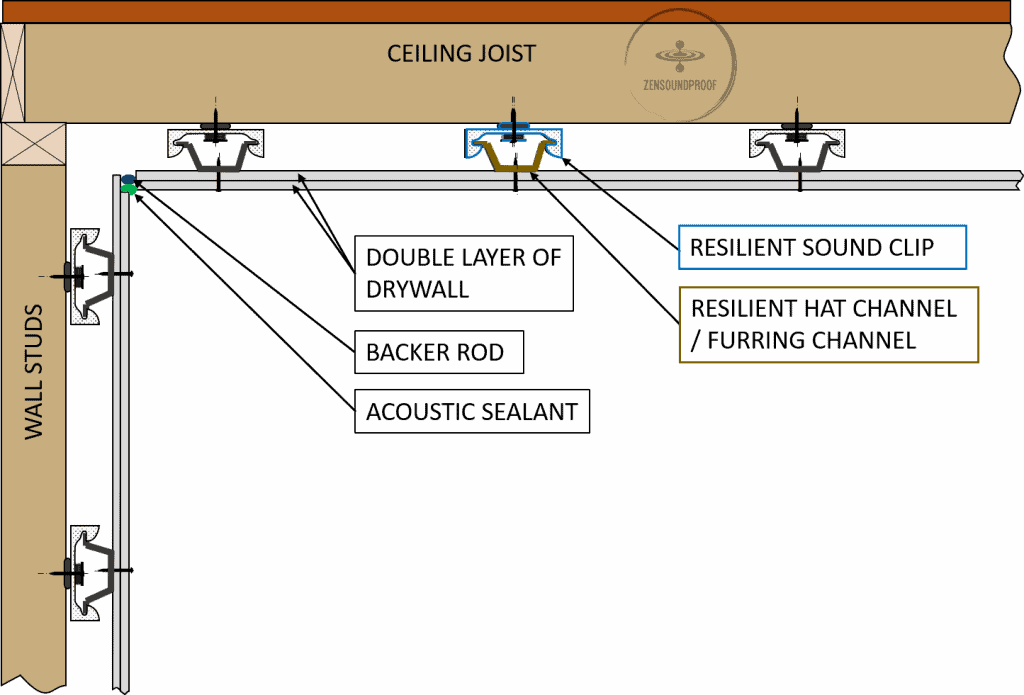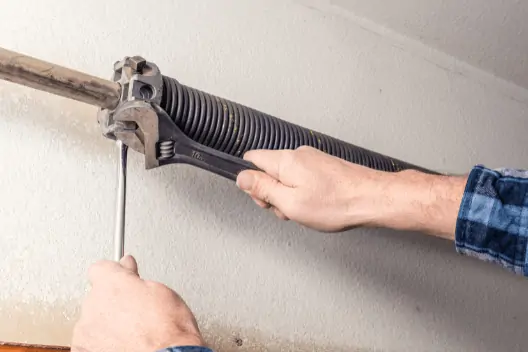Having a loud garage door makes operating it annoying, particularly if you need to use the garage during unsociable hours.
Luckily, there are various ways to make a garage door quieter.
In this article, I’ll explain how to quiet a garage door, regardless of type. Hopefully, by the end you’ll have at least one actionable solution for solving your garage door noise.
How to Quiet a Garage Door
So, how do we quiet a garage door? While the solution does depend on the noise source, there are plenty of options that are simply good maintenance.
1. Tighten Everything Up
Often, the cause of a noisy garage door is loose nuts, bolts, and screws. One of the easiest solutions is therefore to tighten everything up.
Constant movement and vibration can loosen these components, causing them to rattle. This is the same as, for example, a chair becoming wobbly over time. It’s caused by the repeated loads of sitting and standing, which is the same principle in action here.
Before trying a more invasive solution, start by inspecting the garage door’s parts for loose screws and bolts. Tighten these using the appropriate tools, and you might solve the problem.
2. Lubricate Moving Parts
Another common issue is that your garage door’s moving parts need oiling. You’ll know this is a problem if your door squeaks or creaks while opening.
Use a silicone or lithium-based lubricant specifically designed for garage doors. This’ll help to prevent residue and rust.
Apply the lubricant to:
- The hinges
- The springs
- Door rollers
- The lock
- The rails
I recommend checking out this video for a clear guide on how to lubricate a garage door.
3. Install a Quiet Garage Door Opener
A noisy garage door opener can be a real problem for everyone else in the property. The chain rattles, the door rattles; it’s not a pleasant experience.
Automatic garage doors are convenient but a noisy garage door opener makes them annoying.
If your garage door is automatic, consider installing a quiet garage door opener. These use different opening methods or include sound-absorbing materials.
Choosing the right one for your needs can be difficult, though. I’ve previously written about the best quiet garage door opener. Check the post out if you want more information.
4. Replace the Door Rollers
Garage door rollers are a simple but vital piece of the door setup. They roll along the door’s rails to keep it on track as it opens and closes. You’ll find them on manual and automatic garage doors.
Most garage doors use steel rollers because they’re the most hardwearing. But, as you can imagine, rolling steel over metal rails makes a lot of noise.
Also, over time, rollers of any kind become damaged through continuous use. If this is the case, you might hear a rattling or popping noise during operation.
A simple fix is to lubricate them, as explained in the solution above. But, a more effective solution is to replace them entirely.
The best options for quiet garage door rollers are Teflon and nylon rollers. Using plastic instead of metal provides much smoother operation, and, importantly, less noise.
But, quiet garage door rollers made from plastic wear out quicker. So, if you decide to go with one of these options, be sure to inspect them more regularly and replace them when you see signs of damage.
It might be worth calling out a professional for help. If you’re happy to try it yourself, watch this video for tips on how to change garage door rollers.
5. Use a Garage Door Silencer to Isolate the opener
If you don’t want to completely replace a noisy garage door opener, the next best solution is to isolate it.
The motor housing is usually fixed directly to the ceiling joists. This causes vibrations to pass into the structure, allowing them to travel through your home.
Luckily, this is a pretty easy fix with some simple DIY. It relies on the soundproofing principle of decoupling (mechanical isolation). You might already know this is one of the most effective ways to soundproof a space.
Separating the noise source from a structure essentially cuts off the transmission path for sound waves. We use it to isolate one side of a wall from the other, but we can also apply it here on ceilings.
For this, you’ll either need:
The isolation pads are much easier to install because you put them between the motor’s mounting bracket and the ceiling. You can put a second pad under the bracket for more isolation.
Bear in mind, you’ll need longer screws than before because you’re adding roughly an extra inch to the setup.
To use resilient channels for a noisy garage door opener, do the following:
- Fix the resilient channels to the ceiling as normal.
- Attach the isolation clips to the channels. They simply clip on.
- The isolation clips have a hole in the middle for screws. You should be able to attach the motor’s mounting bracket directly to them.

How you set the resilient channels up will depend on your motor’s mounting bracket. If it’s already fitted to the ceiling, remove it and copy the original screw pattern.
6. Replace the Garage Door Springs
Garage door springs aren’t the main culprit for excess noise, but they can contribute to it. Older door models often use extension springs, which can wobble when in use.
This isn’t necessarily a bad noise. Over time, though, they can wear out and start to squeak and creak.

It’s best to replace them before they break, as extension springs can be dangerous when they snap. Hearing creaking sounds is one sign you need new springs.
When it comes time to replace them, consider opting for torsion springs (more infor here). They release angular energy, making them efficient at opening garage doors.
What’s more, they’re harder wearing and make less noise than extension springs. You’ll still need to regularly maintain them but you should find they last longer.
Torsion and extension springs aren’t directly interchangeable, but converting the garage door from one to the other isn’t difficult. Consider checking out this video for more information.
Ideally, you should get a professional to replace your garage door springs. Torsion and extension springs are both designed to hold energy and can be dangerous if not handled properly.
Removing them is as simple as opening the door to relieve the tension and then unhooking the springs. Even so, get a professional to do it for you.
7. Insulate the Garage Door
Standard construction materials for garage doors include aluminum, vinyl, or steel. These are great for transmitting vibrations and contribute to the overall problems of a noisy garage door.
One solution for quiet garage doors is to make the actual doors less likely to vibrate. Insulating them with the correct material can help to improve their STC rating, which I’ve discussed in my article about floor underlays.
In short, you’ll want to either add a combination of mass and dampening materials. The material you can use depends on the type of garage door you have.
For example, you won’t be able to do much to a rolling garage door. Fitting rigid materials will prevent it from rolling up. But, if you have a solid garage door, you have plenty of options.
I recommend using something like mass loaded vinyl or a sound deadening mat. Both are dense and help to deaden vibrations passing through a structure.
Make sure you check that your door opener can handle the extra weight. Most door openers are oversized, so this is unlikely to be an issue. Check out my article on the best quiet door openers linked above for clearer information on power/weight ratios.
Installation is easy for both, but sound deadening mats are the simpler of the two. Ones for vehicles have a self-adhesive backing, which you just peel off.
If using mass loaded vinyl, you’ll need a specialist vinyl cement. Whichever you choose, try to cover as much surface area as possible.

Final Thoughts on How to Quiet a Garage Door
Hopefully, one of the solutions above will help solve your noisy garage door problems.
I recommend starting with the simpler options, such as tightening bolts, before moving onto a more complex solution.
Have you tried any of these before? If so, let me know how you got on in the comments below.






1 thought on “7 Easy Ways How to Quiet a Garage Door – Everything Explained”
Nice….. I (65 year old female) just greased and tightened all the bolts to my garage. Even had to run to the store for some bolts that were missing. Now? My garage sounds brand new! Thank you for the information.